Climate Change in Our World II, exhibited in Munich and Brussels, 2014 (2)
Part 1, prints 1-16. Part 2, prints 17-32.
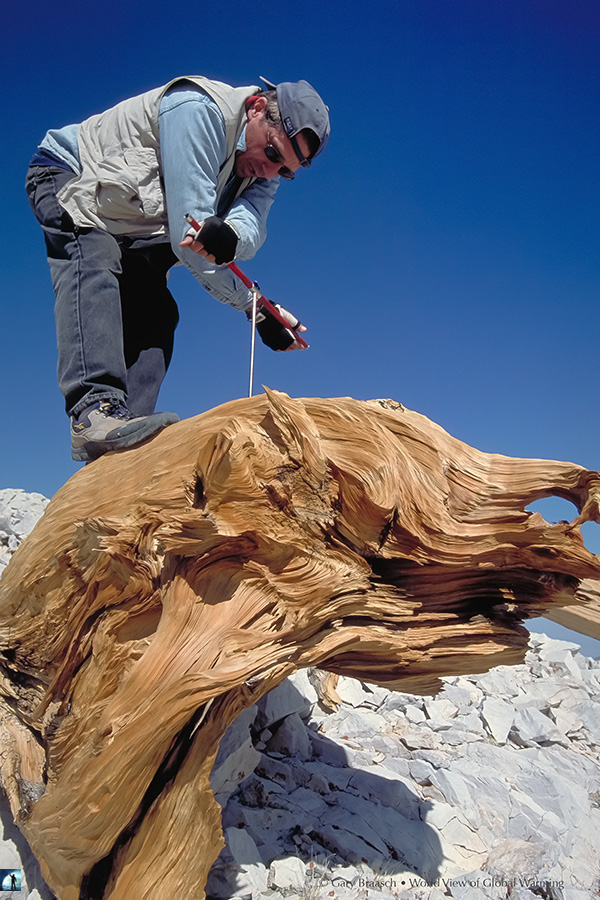
History of climate is recorded in the growth rings of ancient trees
Dr. Matthew Salzer extracts a tree core from the stump of a bristlecone pine at about 3400 m high in southern California mountains. These trees are among the oldest living things. The oldest specimen known is about 5000 years old and germinated during the age of the Pyramids in Egypt. Growth rings of most temperate zone trees are created each year and show the conditions in which the tree lived. When matched with tree rings from even older, dead trees, bristlecone tree rings give a picture of regional climate going back about 9,000 years. Over the last half century, many of these trees appear to have grown faster than in any period over the last 3700 years, suggesting that temperatures are warming. But this warming appears to be contributing to the spread of a fungal disease and attacks by bark beetles, both of which are moving into high elevation bristlecone habitat that was once inhospitable to the pests.

Monarch butterflies — long distance migrants in North America — suffer greatly from stress of habitat loss and climate change
Monarch butterflies mating in Maine, USA, at the culmination of their migration north. Monarchs perform one of the longest multi-generational migrations, flying north from forested wintering sites in central Mexico to breed and lay eggs on spring growth of the milkweed plant in North America. Successive generations of insects live in the northern plains and farmland of the United States and southern Canada. In autumn, the third or fourth generation of monarchs of the year arecued by temperature and day-length to fly up to 3000 km back to Mexico to overwinter. This life cycle makes the insect extremely subject to loss of habitat and climate change – logging of roost trees in winter habitat, destruction of milkweed in American farmland, stronger storms with ice. The number of Monarchs overwintering in Mexico has plummeted more than 90 percent in the past 20 years.
Biodiversity and crucial habitats are at risk. Rising temperatures, increasing disease, loss of habitat drives migration and extinctions.
Some of the tiniest and most beautiful creatures are losing habitat and their normal living conditions as the climate changes. Tropical frogs and toads like this Atelopus varius of Central America are disappearing -- some due to higher temperatures and others due to a rampant fungus which climate changes seem to encourage. Many butterflies, insects and migrating birds in Europe, Africa and North America are trying to adapt by moving to more favorable climate conditions. This Edith’s checkerspot butterfly’s range moved hundreds of miles north in Canada and the United States.
Unnatural climate change is happening so fast that it is one driver of rates of extinction that are estimated at “1000 times" the normal rate over prehistoric time. Authors of a new study warn that most plant and animal species on Earth are still unknown: We don’t even know how many there are or their benefits to life on earth.
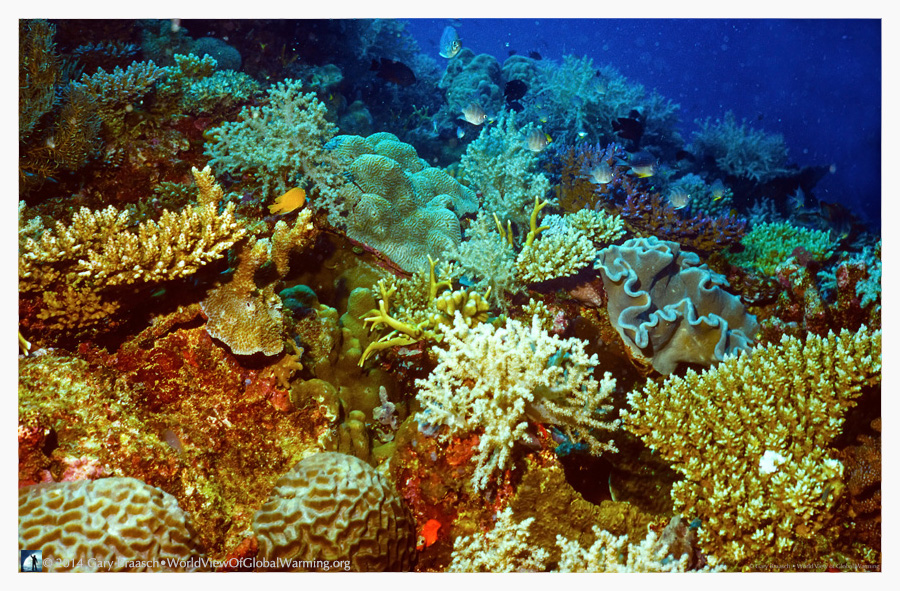
Ocean changes push rich coral reefs to the brink. Australia’s Great Barrier Reef faces dangerous heat and acidity.
The 1,200-mile long Great Barrier Reef is the world's greatest coral ecosystem, the most complex on the planet, and home to a myriad of
species ranging from whales and sharks to bacteria. Reefs are made of the calcium carbonate skeletons of the coral polyp. They offer coastal protection to eighty-six nations and provide fishing, pharmaceutical discoveries, and tourism income estimated at above $375 billion.
Climate change threatens coral reefs with rising temperatures and increasing acidity of the oceans from the uptake of CO2, and there is “little scope for adaptation” according to scientists. At the same time, tiny shell-building phytoplankton—the base of the food chain and source of more than one third of the Earth’s oxygen—may lose their ability to make shells as carbon dioxide's acidic effect increases.
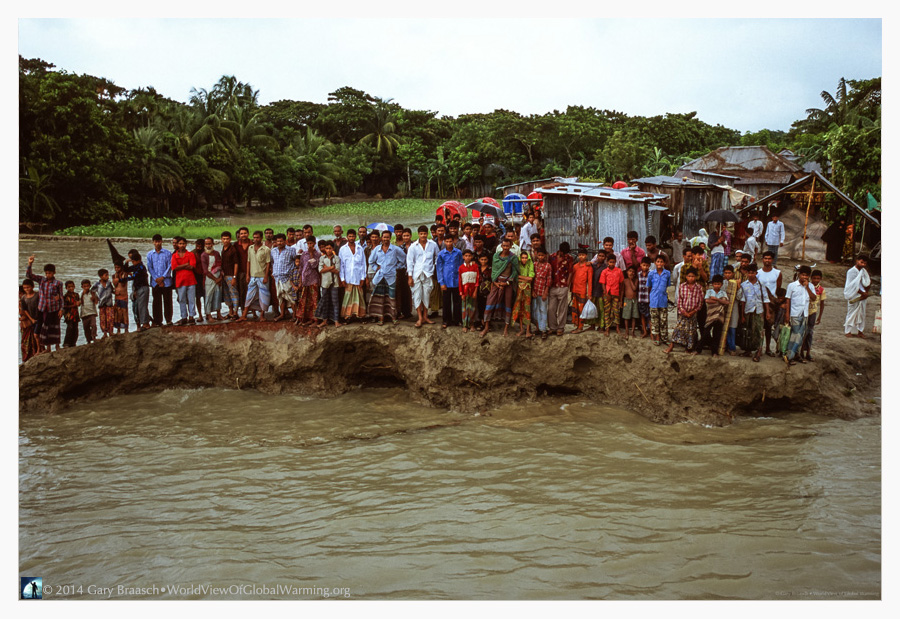
Villagers on the edge of change in their river delta. Residents of Bhola Island, Bangladesh, on a road sliced by active erosion.
These villagers are among more than 16 million people living only a few feet above high tide in this huge delta of the Ganges and Brahmaputra Rivers. Bangladesh is made up of 90 percent floodplain and faces rising sea level, making flood and cyclone damage much more severe. Yet, like much of the less-developed world, Bangladesh creates very little greenhouse gas. The total average carbon dioxide output of all the Bangladeshis seen here combined is about equal to that of two Americans.
About two thirds of the world’s major cities are coastal. Coastal residents, wealthy or poor, all face the same threat. Scientists currently estimate that the sea level will rise by at least three feet before 2100, inundating estuaries, harbors, and the homes of millions.
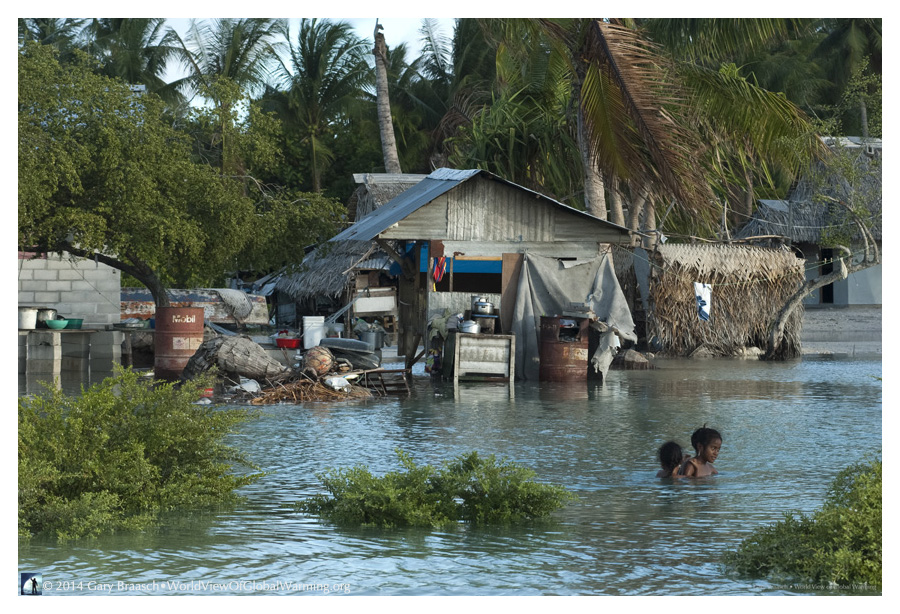
Island nations swamped by rising seas. Kirbati and other Pacific island nations face losing land and culture.
Kiribati’s highest point is only 3.5 m above sea level, and much of the Pacific Island nation is beset by rising sea levels. High tides percolate up through the coral to flood vegetable gardens and fields, and float waste and garbage into villages.
This tiny country of about 100,000 people is one of the small island nations, including Tuvalu, The Maldives, Marshall Islands and Caribbean countries, demanding strong global action to stem sea level rise caused by climate change. Tuvalu and Kiribati have been negotiating with Australia and New Zealand to find a way to move their populations while preserving their cultures. Should any of these places become uninhabitable, it would challenge international standards of justice, sovereignty, human rights and national security.
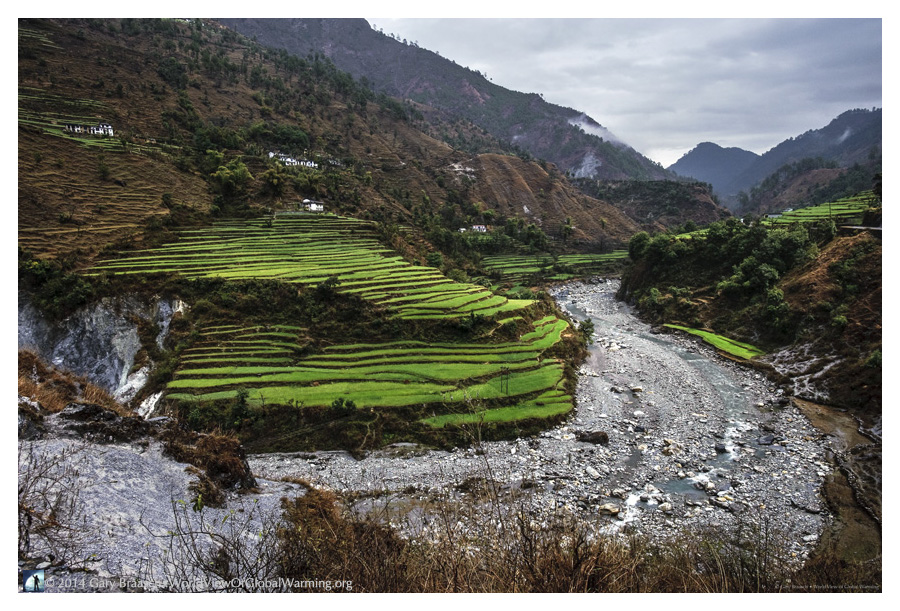
Landslides intensify in the Himalaya foothills. Villages in steep valleys see increase in unusually heavy, unpredictable rains which kill thousands.
These agricultural terraces and grazing land on the Revati River in Bageshwar District of Uttarakhand, India, have been frequently eroded by severe rainfall. The mountainous and heavily populated region of the Himalayan foothills has long been the scene of landslides and river flooding during the predictable rains of the monsoon.
Historically, most slides are set in motion in June, July and August and about ninety percent of the fatalities occur in those months. In recent years, however, according to studies and reports, more residents are the victims of unexpected storms frequently outside the expected monsoon months. The most recent severe landslides killed 6,000 Indians in Uttarakhand in 2013. Intense and prolonged rain, and storms at unusual times of the year, are among the predicted effects of a warming climate.
Braasch copy.jpg)
Refugees fleeing climate changes as well as war. Camp in northern Kenya houses families displaced by conflict, drought and flood.
Refugees in this camp in Kenya fled from war, lost their livestock in severe drought but were also facing unusually heavy rains when this photograph was taken in 2006. The climate of Africa is complex and subject to severe swings from drought to deluge, but climate experts say drought is likely to increase as temperatures rise, evaporation increases and human population and need for water continue to grow.
Africa, as well as the Middle East and parts of Asia, show the growing link between climate change and conflict, in which competition for water, food and grazing lands made scarce by global warming can ignite and exacerbate war. Climate refugees, also called environmental migrants, and the fate of the world’s poor suffering from the effects of climate change, pose major ethical and human rights issues.
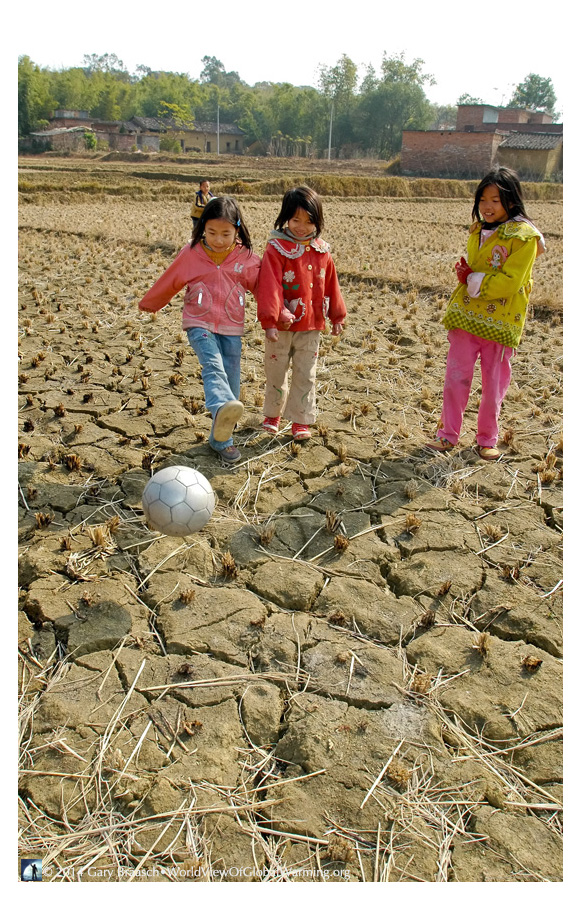
Drought affects Chinese rice harvest as nation’s emissions grow. Children playing in the desiccated rice fields of their village in Guangdong.
Large regions of China are beset with drought, failing crops, and sandstorms linked to global warming. Guangdong Province, China, suffered an extended drought in 2005, for example, and in some areas like this village no rice was harvested at all. Fish ponds and wells that had been relied on for hundreds of years dried up.
China is now the world's largest carbon dioxide polluter (up to a third of it produced from manufacturing export products) and first in coal consumption—three-quarters of their power comes from coal. Yet China is also the largest wind power generator and a leading exporter of turbines, and is the world’s top manufacturer of photovoltaic panels. Like the United States, China has the technological capability to lead the world in reducing carbon pollution.
BraaschBraaschBraasch.jpg)
Trees for Africa and the World, the Legacy of Wangari Maathai. The Greenbelt Movement changes ecosystems, climate and lives.
Women from a village near Nairobi, Kenya, plant trees grown in their own nursery, an action of the Green Belt Movement. This environmental organization was founded in 1977 by Wangari Maathai (1940-2011) of Kenya in response to reports from women that their streams were drying up, their food supply was less secure, and they had to walk further and further to get firewood. Scientists also encourage tree planting as very important for carbon sequestration and cooling.
The 4,000 local groups of the Green Belt Movement in Kenya plant about five million trees each year -- 51 million total since 1978. The NGO not only empowers communities, particularly women, to conserve the environment and improve livelihoods but has inspired similar groups all over the world, including Plant for the Planet, in Germany.
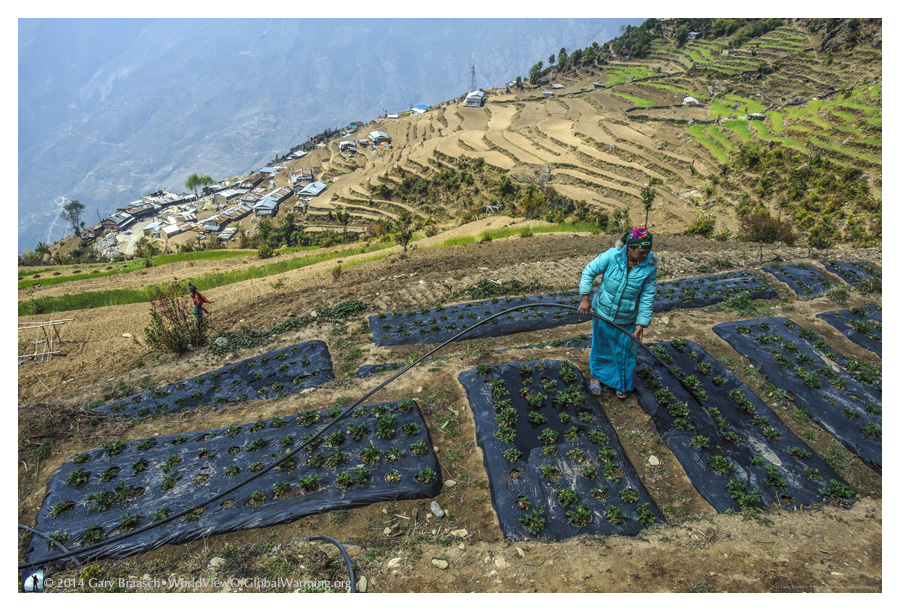
Farmer in Nepal adapts to change. Climate shifts in steep Himalayan valleys require new crops and water management.
Farmer Mempayhelmo Tamang waters her new strawberry plants in Ramche, Nepal, “Village of Landslides” in the buffer zone of Langtang National Park. The precarious life here now also includes reacting to the one-two punch of warmer and dryer climate. This far-sighted woman farmer parlayed help from a WWF farmer school into a new cash crop of 1500 strawberry seedlings, the first in her area, and new ponds to collect rainwater for irrigation.
She epitomizes the millions of rural people of little means who are adapting season by shifting season, not only trying new crops but also establishing seed banks and varietal testing, bringing livestock off open range to control and use the natural fertilizer from waste, collecting rainwater from roofs and digging storage ponds, and experimenting with biogas and solar power.
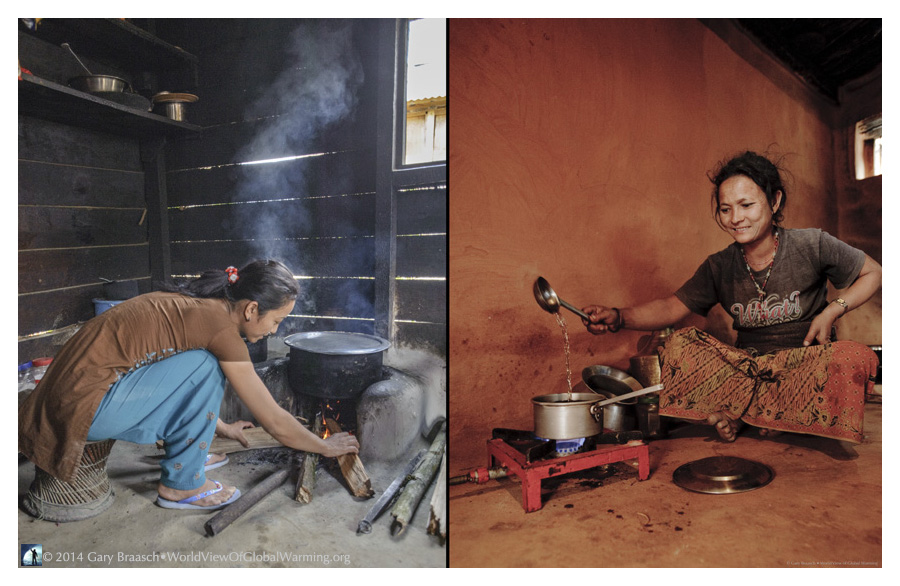
Women’s health tied to cooking and climate change. Families, forests, and world’s climate all benefit from better stoves and biogas.
Estimates are that families heating and preparing food over biomass fires – wood, grass, dung and farm residues -- endanger the health of three billion people. The World Health Organization estimates that 1.5 million people die of soot-related ailments yearly. In Maimajhuwa, Nepal, fresh roti (donuts) were being prepared in oil heated by forest wood. A worldwide drive has begun to cut back on emissions of soot (black carbon) not only because of its ill effects on health, but also due to its contribution to global warming and the melting of glaciers.
One solution to all issues is biogas. The seven households in the tiny village of Pairebensi, Nepal, put the manure of animals, plant residue and human waste into a cement tank to generate methane piped to each home. The cost in Nepal for these installations was about US$650 for each household.
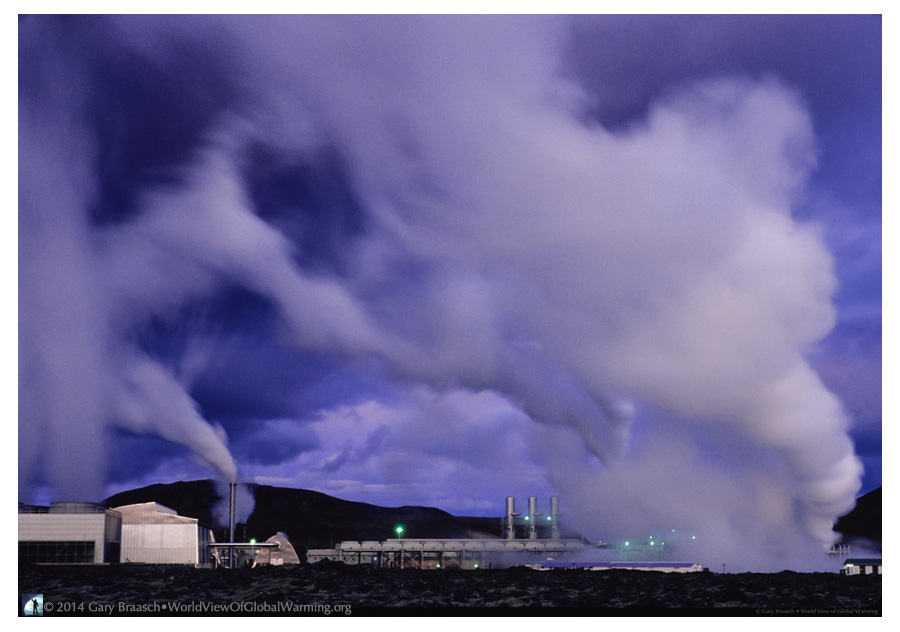
Power direct from the Earth, geothermal has yet to reach its potential. Many locations, including Africa’s rift valley, are hot prospects for this electrical generating source.
Iceland’s Svartwengi geothermal power station, which uses steam to make electricity for Reykjavik, is adjacent to the famous Blue Lagoon thermal springs. Geothermal electrical power has potential in places where volcanic heat is safely accessible. In 24 nations where geysers and volcanic steam vents spring forth, geothermal electrical generating capacity is producing about 10,000 megawatts, but many locations are unexploited. California, the Philippines, Italy, Mexico, and Indonesia are leaders in the amount of energy produced, but only Iceland is heavily dependent on geothermal. In many other nations, geothermal is used to heat buildings. This power is a natural choice in Africa’s Great Rift Valley, but so far only one utility, in Kenya, is tapping this enormous volcanic resource that could serve so many under-electrified nations.
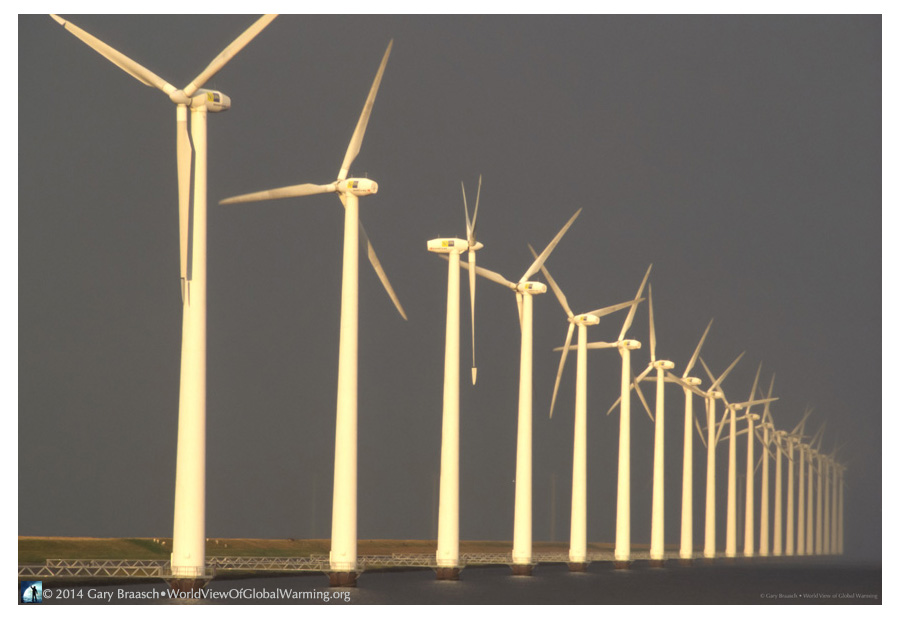
Clean renewable energy from wind, sun and water is advancing. Wind turbines in the Netherlands displace fossil fuel power needs.
This array of wind turbines in Flevoland, The Netherlands, signals the promise of wind power and indicates independence from polluting fossil fuels. People have been using wind, water, biofuels, and sunlight for thousands of years, and supplies of wind and solar energy on accessible land dwarf the energy we consume. Radiation from the sun each hour strikes the Earth with more energy than humans use in a year. Vast geothermal heat, wave energy, tide and ocean thermal energy are also available.
Nations like Germany and Denmark are generating more than 20 percent of their power from renewable energy, largely solar and wind. France, heavily invested in nuclear power, is also building renewable power systems. However, worldwide most non-fossil fuel energy is from hydroelectric dams and polluting and unsustainable wood and biomass fires.
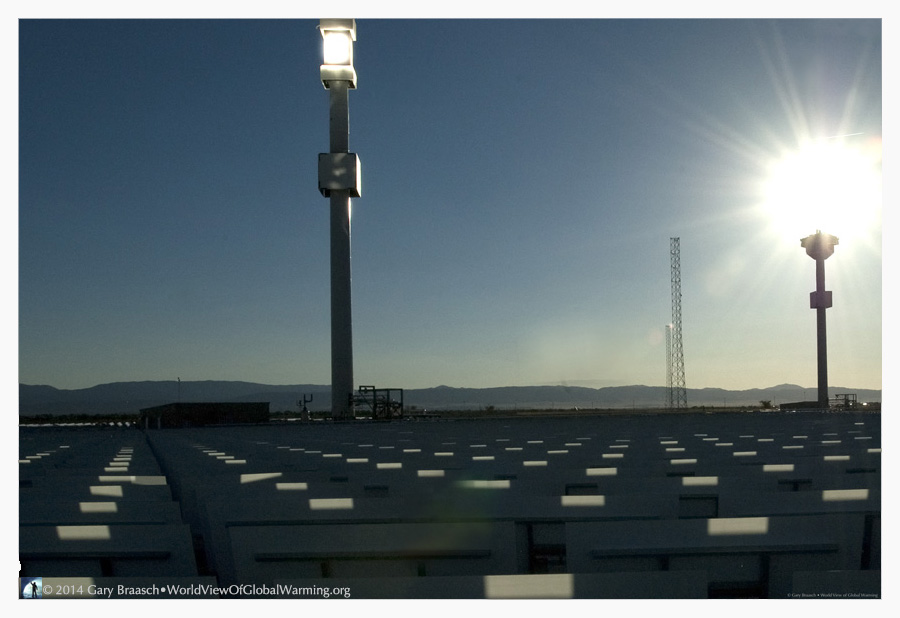
Solar power burning brightly from California to Spain and Germany. U.S. concentrated solar array is largest in the world; Germany leads in photovoltaic power.
After starting slowly with demonstration projects like this one in California, the U.S. now has more than a gigawatt of concentrated solar coming on line in 2014, giving Spain, the world leader in power from centralized solar stations, strong competition. The new 392 mw Ivanpah Solar Facility in California's Mojave Desert is the world’s largest solar thermal power plant. Concentrated solar uses thousands of flat or concave mirrors to focus heat from sunlight to create steam to turn turbines.
The output from these utility scale industrial solar plants is dwarfed by the common and successful use of direct photovoltaic (PV) electrical power. Germany’s PV installations on thousands of homes, farm buildings and roadsides generate 36 gw, double that of Italy and four times that of China and the U. S. The price of individual PV panels is falling rapidly, promising local power on millions more roofs, buildings and roadsides.
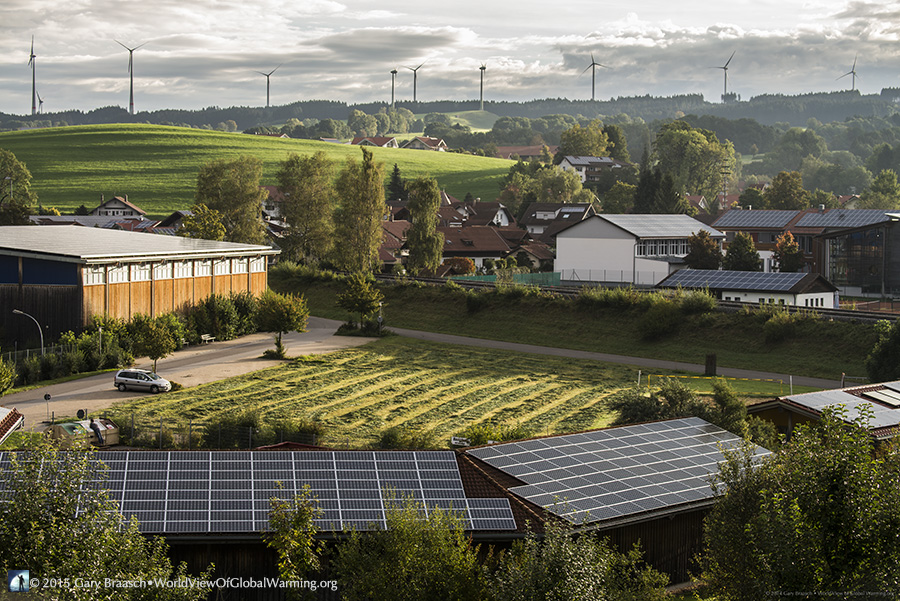
Germany’s renewable energy program — Energiewende — transforms the countryside and the sources of electricity
Germany’s clean power revolution is epiomized by the Bavarian homes, community buildings and milking parlors, not to mention offices, sheds, and schools, almost totally covered with solar panels. The farming town of Wildpoldsreid also uses farm-waste biogas and seven wind turbines, and can generate up to three times its local electrical needs. The deputy mayor of Wildpoldsreid, Gunther Mogele, said the village of 2500 decided to do this to save money, encouraged by Federal German laws. He said the village solar roof coverage is actually only 37 percent, but that now that the systems are proven “almost everyone wants to join.” Germany's 1.4 million solar energy systems produced 6.9 percent of Germany’s net electricity consumption in 2014. Renewable energy altogether — wind, biomass/biogas, and hydro — accounted for 31 percent of electrical consumption.
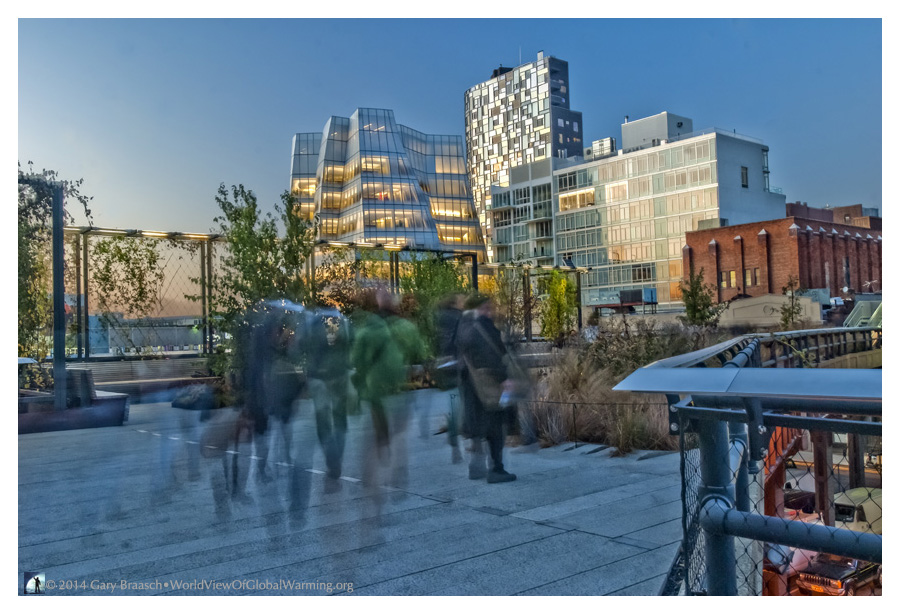
High Line Urban Park, New York City. A repurposed 19th century railroad line drives urban efficiencies.
The High Line is a public park built on an historic freight rail line elevated above the streets of Manhattan’s West Side. Opened in 2009, it has driven an economic transformation of the neighborhood and encouraged energy efficient travel, recreation and building. Prominent nearby buildings employ LEED (Leadership in Energy and Environmental Design) features like water recycling, rainwater collection, natural air flow, and integrated solar. Overall, due to energy awareness and economies of scale. New York runs on half the energy per capita of many other major cities.
Cities are not only affected by climate change, but are major contributors to carbon pollution and energy over-use. Inefficient building lighting and air conditioning, for example, can waste one-fifth of a city's power. Mounting photovoltaic solar panels on even a portion of parking lots and building rooftops can generate much of a city's electricity needs.
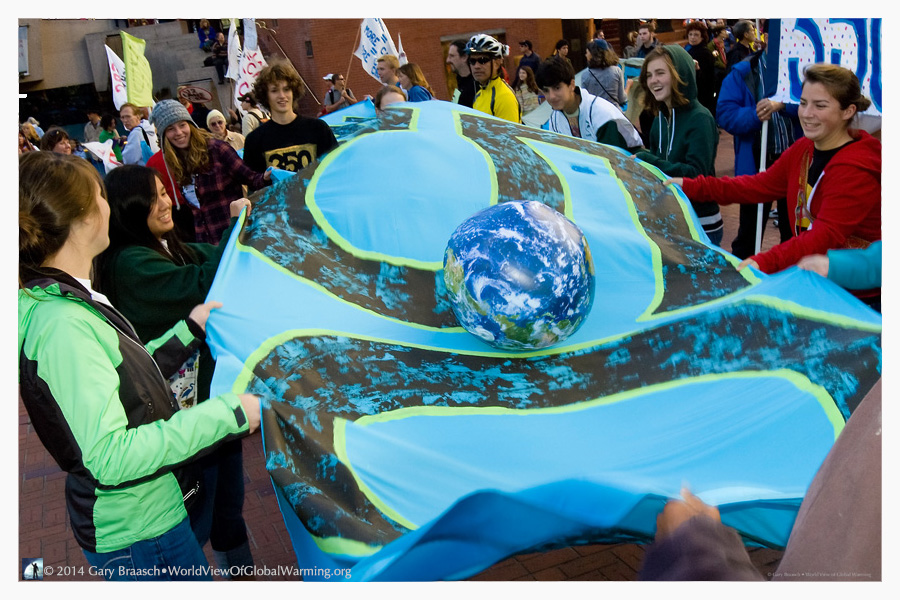
Citizens of the world go public about their climate concerns. Thousands of NGOs focus peoples’ concerns and calls for action.
Heeding Gandhi – “You must be the change you want to see in the world” -- millions of people are taking part in public demonstrations, lobbying, and local meetings to encourage civic actions about climate change. Concerned citizens can join others through a wide range of organizations.
Long established NGOs like the Student Public Interest Research Groups (SPIRGs), WWF, Greenpeace, and Friends of the Earth have strong climate programs. Groups specifically about climate number more than one thousand, including Climate Solutions, The Climate Institute, The Reality Project and Climate Action Network, an alliance of 700 groups very active during international climate negotiations. 350.org, started at a university in 2008, has fostered local actions in 188 nations. At the more local level, one can work with civic associations, parent and teacher groups and youth environmental programs.
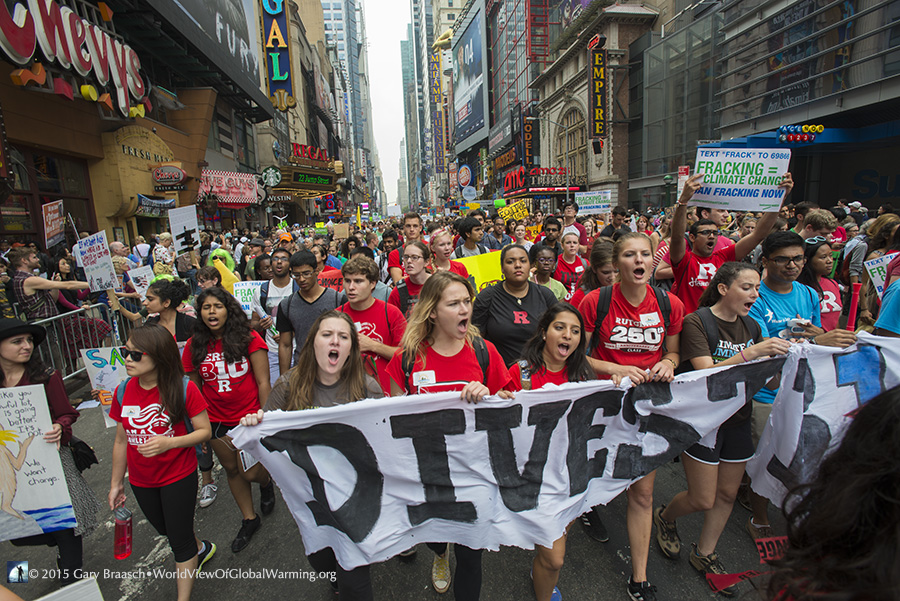
People’s Climate March fills New York streets calling for action on interconnected global warming, health, poverty and labor issues
Enthusiastic college women urging divestment from fossil fuel company stocks are among the 300,000 plus who jammed 6th Avenue and 42d street through Times Square in New York City on Sept 21, 2014 for the People’s Climate March — described as the largest public display of support for action to limit climate change and it effects on communities, the poor, native people, workers, and our food. The active, strong voiced, diverse and creative multitude filled New York City’s broad avenues from sidewalk to sidewalk for more than five hours during the demonstration. People were happy and apparently mostly optimistic and well informed, sharing information about their particular concerns, engaging with spectators, and joyfully waving signs and banners. More than 1500 organizations from across the U.S. and many nations took part in organizing logistics and attendance, representing the poor, labor, native American, climate solutions, peace, anti-corporate campaigns, youth, scientists and local environmental groups. Many thousands of individuals and families also come to add their own independent aspiring and determined voices.
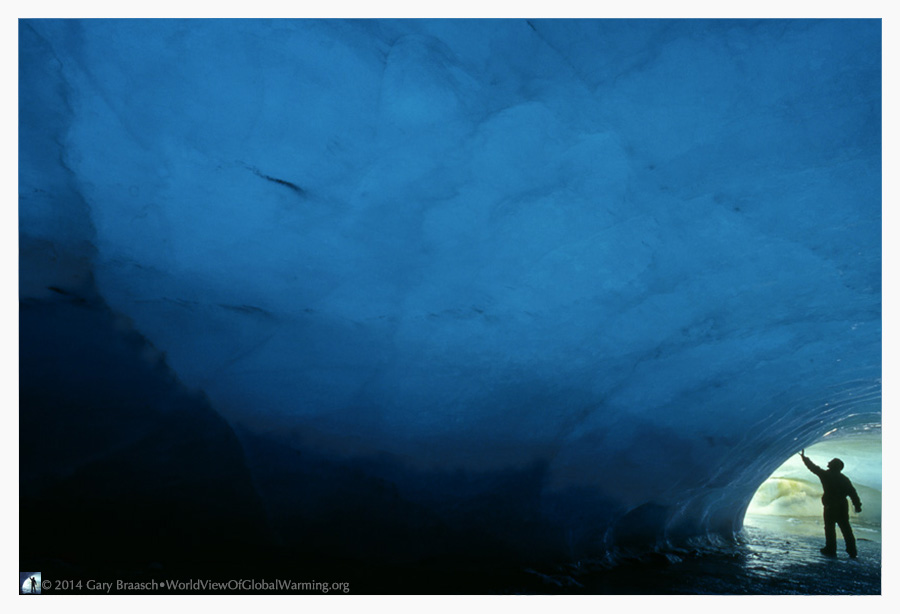
Antarctic ice cave.
A member of an Antarctic science team touches glacier ice near the Palmer Station U.S. research base – a symbol of both human curiosity and human effects on nature. A few years after this photograph was taken this ice cave in Marr Glacier, Anvers Island, Antarctica, melted away. Like hundreds of others on the Antarctic Peninsula, the face of this glacier is rapidly receding and breaking apart in response to warming temperatures. Antarctica was the first location for the photojournalism of World View of Global Warming (1999-present), the source of the photographs in this exhibition. All photography and text copyright © 2014 Gary Braasch.
This project would be impossible without scientists and observers around the world who have provided hundreds of scientific contacts and papers. See Background, Advisors, and Reference for documentation, funders and major advisors, without whom I could not complete the work.
World View of Global Warming is a project of the Blue Earth Alliance, Seattle Washington, a 501(c)3 tax-exempt organization. The project is supported entirely by donations, grants, and license fees for the photographs. Please see information about how to contribute.
For other information about Gary Braasch's climate change projects and books, please see the books Earth Under Fire and How We Know What We Know About Our Changing Climate, and the exhibit "Climate Change in Our World" at the Books and Exhibits link on the top menu of this page.
COPYRIGHT NOTICE:
Photography and text Copyright © 2005 - 2017 (and before) Gary Braasch All rights reserved. Use of photographs in any manner without permission is prohibited by US copyright law. Photography is available for license to publications and other uses. Please contact requestinformation@worldviewofglobalwarming.org. View more of Gary Braasch's photography here.


